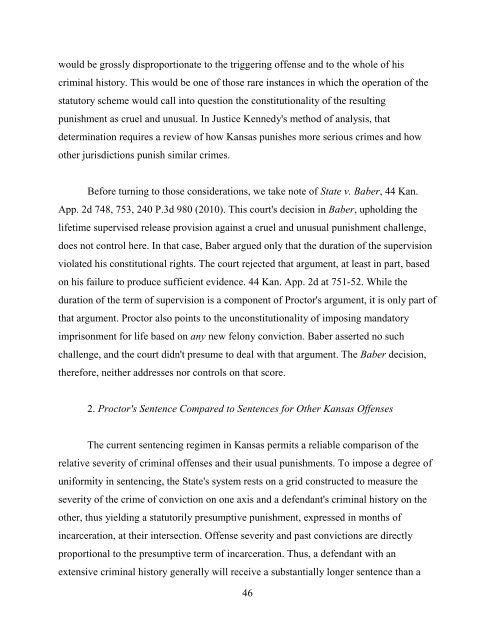State v. Proctor - Kansas Judicial Branch
State v. Proctor - Kansas Judicial Branch
State v. Proctor - Kansas Judicial Branch
You also want an ePaper? Increase the reach of your titles
YUMPU automatically turns print PDFs into web optimized ePapers that Google loves.
would be grossly disproportionate to the triggering offense and to the whole of his<br />
criminal history. This would be one of those rare instances in which the operation of the<br />
statutory scheme would call into question the constitutionality of the resulting<br />
punishment as cruel and unusual. In Justice Kennedy's method of analysis, that<br />
determination requires a review of how <strong>Kansas</strong> punishes more serious crimes and how<br />
other jurisdictions punish similar crimes.<br />
Before turning to those considerations, we take note of <strong>State</strong> v. Baber, 44 Kan.<br />
App. 2d 748, 753, 240 P.3d 980 (2010). This court's decision in Baber, upholding the<br />
lifetime supervised release provision against a cruel and unusual punishment challenge,<br />
does not control here. In that case, Baber argued only that the duration of the supervision<br />
violated his constitutional rights. The court rejected that argument, at least in part, based<br />
on his failure to produce sufficient evidence. 44 Kan. App. 2d at 751-52. While the<br />
duration of the term of supervision is a component of <strong>Proctor</strong>'s argument, it is only part of<br />
that argument. <strong>Proctor</strong> also points to the unconstitutionality of imposing mandatory<br />
imprisonment for life based on any new felony conviction. Baber asserted no such<br />
challenge, and the court didn't presume to deal with that argument. The Baber decision,<br />
therefore, neither addresses nor controls on that score.<br />
2. <strong>Proctor</strong>'s Sentence Compared to Sentences for Other <strong>Kansas</strong> Offenses<br />
The current sentencing regimen in <strong>Kansas</strong> permits a reliable comparison of the<br />
relative severity of criminal offenses and their usual punishments. To impose a degree of<br />
uniformity in sentencing, the <strong>State</strong>'s system rests on a grid constructed to measure the<br />
severity of the crime of conviction on one axis and a defendant's criminal history on the<br />
other, thus yielding a statutorily presumptive punishment, expressed in months of<br />
incarceration, at their intersection. Offense severity and past convictions are directly<br />
proportional to the presumptive term of incarceration. Thus, a defendant with an<br />
extensive criminal history generally will receive a substantially longer sentence than a<br />
46

















